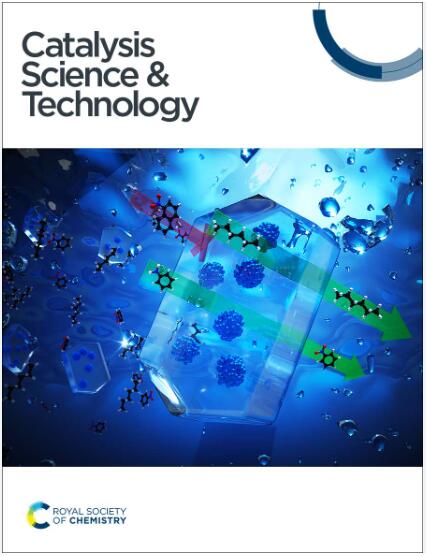设计用于CO2电化学还原反应的分子和二维金属卟啉催化剂
IF 4.2
3区 化学
Q2 CHEMISTRY, PHYSICAL
引用次数: 0
摘要
电化学CO2还原反应(eCO2R)是实现CO2可持续转化为增值化学品的重要途径。然而,开发具有高选择性和高稳定性的高效催化剂仍然是一个挑战。金属卟啉(m - por)是一类极具吸引力的分子催化剂,因为它们的结构框架提供了独特的外周配体的可调节性、金属中心的柔韧性和金属氧化态的通用性。这些特性可以用于调整m - por对eCO2R的催化性能。本文采用密度泛函理论,对具有不同金属中心(Ni、Fe、Cu、Co)、氧化态和锚定配体的M-POR催化剂进行了全面的计算研究,旨在提高C1产物(一氧化碳和甲酸)的选择性生产。热力学和电化学稳定性分析表明,中性m - por比带电m - por稳定得多,这为催化剂设计提供了重要指导。反应途径的机理分析-质子偶联电子转移(PCET)与顺序质子和电子转移(PT-ET) -确定了PCET是非常有利的,对甲酸具有主要的选择性。本研究发现Fe-POR具有较好的催化性能。重要的是,将这些最佳分子催化剂整合到二维(2D)碳质框架中可以进一步提高催化性能,从而确定二维Fe-POR是一种非常有前途的选择性C1产物形成材料,从而为设计有效的eCO2R分子-框架电催化剂提供了合理的框架。本文章由计算机程序翻译,如有差异,请以英文原文为准。
Designing molecular and two-dimensional metalloporphyrin catalysts for the electrochemical CO2 reduction reaction†
The electrochemical CO2 reduction reaction (eCO2R) is an important route toward the sustainable conversion of CO2 to value-added chemicals. However, developing efficient catalysts with high selectivity and stability remains challenging. Metalloporphyrins (M–PORs) represent an attractive class of molecular catalysts because their structural framework offers a unique combination of tunability of the peripheral ligands, flexibility of the metal centre, and versatility of the oxidation state of the metal. These properties can be exploited to tailor the catalytic properties of M–PORs for the eCO2R. Here, we present a comprehensive computational study using density functional theory to systematically explore M–POR catalysts with varying metal centers (Ni, Fe, Cu, Co), oxidation states, and anchoring ligands, aimed at enhancing the selective production of the C1 products (carbon monoxide and formic acid). Thermodynamic and electrochemical stability analyses revealed neutral M–PORs to be significantly more stable than their charged counterparts, providing crucial guidelines for catalyst design. A mechanistic analysis of reaction pathways—proton-coupled electron transfer (PCET) versus sequential proton and electron transfer (PT–ET)—identified PCET as highly favourable, with predominant selectivity towards formic acid. This study identifies Fe–POR as the one showing superior catalytic performance. Importantly, integrating these optimal molecular catalysts into two-dimensional (2D) carbonaceous frameworks led to further enhancement of catalytic performance, identifying 2D Fe–POR as a highly promising material for selective C1 product formation, thus providing a rational framework for designing effective molecular-to-framework electrocatalysts for the eCO2R.
求助全文
通过发布文献求助,成功后即可免费获取论文全文。
去求助
来源期刊

Catalysis Science & Technology
CHEMISTRY, PHYSICAL-
CiteScore
8.70
自引率
6.00%
发文量
587
审稿时长
1.5 months
期刊介绍:
A multidisciplinary journal focusing on cutting edge research across all fundamental science and technological aspects of catalysis.
Editor-in-chief: Bert Weckhuysen
Impact factor: 5.0
Time to first decision (peer reviewed only): 31 days
 求助内容:
求助内容: 应助结果提醒方式:
应助结果提醒方式:


